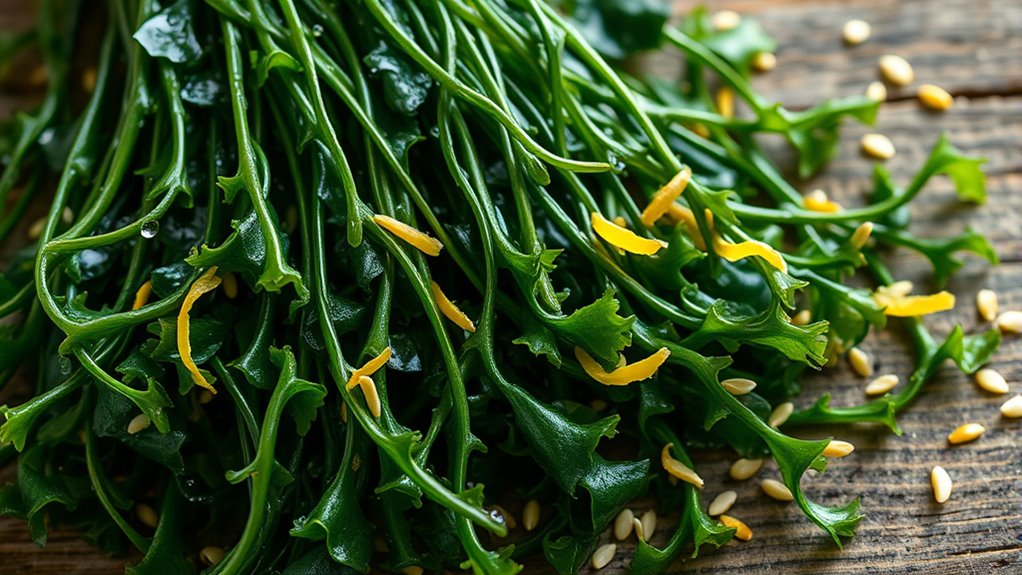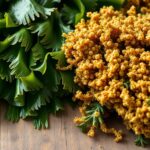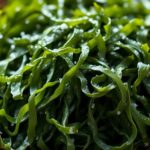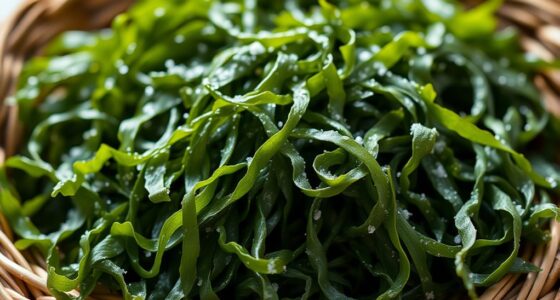Seaweed is quickly becoming a popular, sustainable alternative to kale in vegan recipes. Its natural umami flavor enhances salads, wraps, soups, and snacks, adding rich nutrients like iodine, vitamins, and antioxidants. Easy to incorporate, seaweed requires less water and pesticides, making it eco-friendly. Plus, its versatility opens up many creative options in plant-based cooking. Keep exploring, and you’ll discover plenty of delicious ways to enjoy this oceanic superfood.
Key Takeaways
- Seaweed offers a nutrient-dense, sustainable alternative to kale, rich in vitamins, minerals, and antioxidants for vegan recipes.
- Its umami flavor enhances salads, wraps, soups, and smoothies without added salt or artificial ingredients.
- Easy to incorporate, dried seaweed and powders can season or garnish a variety of vegan dishes effortlessly.
- Seaweed farming supports eco-friendly and renewable food systems, reducing environmental impact compared to land-based crops.
- Using seaweed in vegan recipes promotes health benefits and sustainable eating, making it a versatile “kale” substitute.
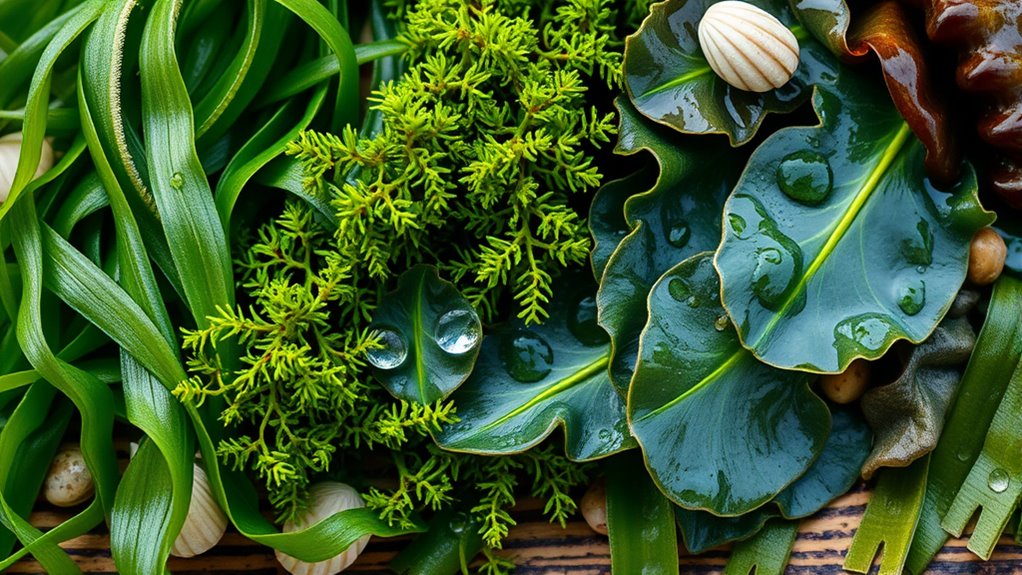
Seaweed vegan recipes offer a delicious and nutritious way to incorporate oceanic flavors into your plant-based meals. As more people seek sustainable and health-conscious food options, seaweed stands out as a versatile ingredient that checks all the boxes. Unlike many land-grown crops, seaweed is harvested sustainably, often through sustainable farming practices that prevent overharvesting and protect marine ecosystems. This method guarantees a continuous supply without damaging the environment, making it an eco-friendly choice for conscientious eaters. When you include seaweed in your vegan dishes, you’re not just adding flavor – you’re supporting sustainable farming practices that reduce the need for freshwater, fertilizers, and pesticides. Plus, seaweed’s rapid growth rate means it can be farmed efficiently, providing a renewable resource that contributes to ecological balance.
Nutritional benefits are another compelling reason to embrace seaweed in your diet. Packed with essential vitamins and minerals, seaweed is a powerhouse of nutrients that can elevate your health. It’s rich in iodine, which supports healthy thyroid function, and contains ample amounts of vitamins A, C, E, and K. Additionally, seaweed offers a good source of antioxidants, fiber, and plant-based protein, making it an excellent addition for vegans looking to meet their nutritional needs. Its natural umami flavor enhances dishes without the need for added salt or artificial flavorings, allowing you to enjoy flavorful meals that are both healthy and satisfying.
Incorporating seaweed into your vegan recipes is straightforward and versatile. You can start by adding dried nori strips to salads or wraps, blending wakame into soups, or seasoning dishes with kelp powder for depth of flavor. Seaweed can also be used to make nutritious snacks like roasted seaweed chips or added into smoothies for a salty, savory note. Its unique texture and flavor profile open up endless culinary possibilities, inspiring you to experiment with ocean-inspired dishes. As you explore these recipes, you’ll notice how seaweed enhances not only taste but also the nutritional value of your meals, making them more wholesome and satisfying.
Ultimately, embracing seaweed in your vegan cooking offers a sustainable, nutrient-dense alternative to traditional ingredients. It supports environmentally friendly farming methods while providing a wealth of health benefits. Seaweed cultivation is an example of a sustainable practice that helps preserve marine ecosystems and ensures a steady supply of this oceanic superfood. By making seaweed a regular part of your menu, you’re contributing to a more sustainable food system and nourishing your body with a superfood that’s as sustainable as it is delicious. So, immerse yourself in the world of seaweed recipes and discover how this oceanic treasure can transform your plant-based meals into flavorful, nutritious delights.
Frequently Asked Questions
Where Can I Buy Fresh or Dried Seaweed Locally?
You can buy fresh or dried seaweed at your local markets and health food stores. Check out farmers markets or Asian grocery stores, which often carry a variety of seaweed options. Many health food stores also stock dried seaweed in their supplement or international food sections. If you prefer online shopping, look for reputable suppliers that deliver quality seaweed directly to your door.
How Do I Store Seaweed to Keep It Fresh?
To keep your seaweed fresh, store it properly using seaweed storage tips like keeping dried seaweed in an airtight container in a cool, dark place. For fresh seaweed, rinse it thoroughly, then store it in a sealed container in the refrigerator, ideally within a few days. Freshness preservation techniques guarantee the seaweed stays moist and retains its nutrients, so you can enjoy its flavor and benefits longer.
Are There Any Health Risks Associated With Eating Seaweed?
Seaweed can pose potential health risks if you overindulge. Excessive iodine intake from large amounts may lead to iodine overdose, causing thyroid issues. Additionally, some seaweed might harbor heavy metal contamination, which can be harmful if consumed frequently. While seaweed offers health benefits, you should be cautious, balancing your intake and choosing reputable sources to avoid these risks and enjoy its nutritious, nourishing benefits safely.
Can Seaweed Be Used as a Meat Substitute?
Yes, you can use seaweed as a protein alternative in your plant-based diets. Its umami flavor and chewy texture make it a versatile meat substitute in various recipes. Incorporate seaweed in wraps, salads, or stir-fries to boost protein intake naturally. As part of your plant-based diet, seaweed adds essential nutrients while providing a satisfying, savory experience that mimics the texture and flavor of meat.
How Do I Prepare Seaweed for Cooking?
Did you know seaweed contains more calcium than milk? To prepare it, rinse thoroughly to remove salt and impurities. Soak dried seaweed in water for 10-15 minutes until it softens, then drain and chop as needed. Incorporate it into traditional dishes like soups, salads, or stir-fries. Its rich nutritional benefits make it a versatile addition, offering a delicious way to enjoy seaweed’s health-boosting properties.
Conclusion
Now that you’ve discovered these vibrant seaweed vegan recipes, imagine the endless possibilities waiting in your kitchen. What secret flavor combinations will you create next? Will you open the perfect balance of saltiness and umami? The ocean’s bounty is calling—are you ready to plunge in and make your meals unforgettable? Don’t wait too long; the sea’s delicious mysteries are excited to be explored by you. Your next culinary adventure is just a bite away.
Ilana has been a vegan for over 10 years. She originally made the switch for health reasons, but soon found herself becoming more and more passionate about the ethical and environmental implications of a vegan lifestyle. Ilana is the author of The Graceful Kitchen, a blog all about veganism. She loves to cook up delicious and nutritious vegan meals, and share her recipes with others who are interested in leading a cruelty-free life. Ilana is also a strong advocate for using whole foods as the foundation of a healthy diet, and believes that going vegan is one of the best ways to achieve this.
